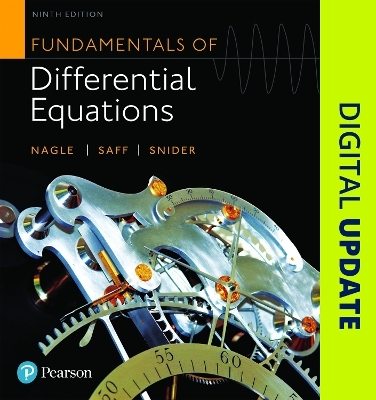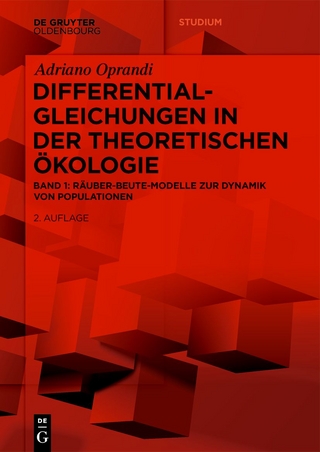
Fundamentals of Differential Equations
Pearson (Verlag)
978-0-321-97706-9 (ISBN)
An introduction to the basic theory and applications of differential equations
Fundamentals of Differential Equations presents the basic theory of differential equations and offers a variety of modern applications in science and engineering. This flexible text allows instructors to adapt to various course emphases (theory, methodology, applications, and numerical methods) and to use commercially available computer software. For the first time, MyLab™ Math is available for this text, providing online homework with immediate feedback, the complete eText, and more.
Note that a longer version of this text, entitled Fundamentals of Differential Equations and Boundary Value Problems, 7th Edition, contains enough material for a two-semester course. This longer text consists of the main text plus three additional chapters (Eigenvalue Problems and Sturm–Liouville Equations; Stability of Autonomous Systems; and Existence and Uniqueness Theory).
Also available with MyLab Math
MyLab™ Math is an online homework, tutorial, and assessment program designed to work with this text to engage students and improve results. Within its structured environment, students practice what they learn, test their understanding, and pursue a personalized study plan that helps them absorb course material and understand difficult concepts.
Note: You are purchasing a standalone product; MyLab does not come packaged with this content. Students, if interested in purchasing this title with MyLab, ask your instructor for the correct package ISBN and Course ID. Instructors, contact your Pearson representative for more information.
If you would like to purchase both the physical text and MyLab, search for:
0134665686 / 9780134665689 Fundamentals of Differential Equations Plus MyLab Math with Pearson eText -- Access Card Package
Package consists of:
0321431308 / 9780321431301 MyLab Math -- Glue-in Access Card
0321654064 / 9780321654069 MyLab Math Inside Star Sticker
0321977068 / 9780321977069 Fundamentals of Differential Equations
R. Kent Nagle (deceased) taught at the University of South Florida. He was a research mathematician and an accomplished author. His legacy is honored in part by the Nagle Lecture Series which promotes mathematics education and the impact of mathematics on society. He was a member of the American Mathematical Society for 21 years. Throughout his life, he imparted his love for mathematics to everyone, from students to colleagues. Edward B. Saff received his B.S. in applied mathematics from Georgia Institute of Technology and his Ph.D. in Mathematics from the University of Maryland. After his tenure as Distinguished Research Professor at the University of South Florida, he joined the Vanderbilt University Mathematics Department faculty in 2001 as Professor and Director of the Center for Constructive Approximation. His research areas include approximation theory, numerical analysis, and potential theory. He has published more than 240 mathematical research articles, co-authored 9 books, and co-edited 11 volumes. Other recognitions of his research include his election as a Foreign Member of the Bulgarian Academy of Sciences (2013); and as a Fellow of the American Mathematical Society (2013). He is particularly active on the international scene, serving as an advisor and NATO collaborator to a French research team at INRIA Sophia-Antipolis; a co-director of an Australian Research Council Discovery Award; an annual visiting research collaborator at the University of Cyprus in Nicosia; and as an organizer of a sequence of international research conferences that helps foster the careers of mathematicians from developing countries. Arthur David Snider has 50+ years of experience in modeling physical systems in the areas of heat transfer, electromagnetics, microwave circuits, and orbital mechanics, as well as the mathematical areas of numerical analysis, signal processing, differential equations, and optimization. He holds degrees in mathematics (BS, MIT; PhD, NYU) and physics (MA, Boston U), and is a registered professional engineer. He served 45 years on the faculties of mathematics, physics, and electrical engineering at the University of South Florida. He worked 5 years as a systems analyst at MIT's Draper Instrumentation Lab, and has consulted for General Electric, Honeywell, Raytheon, Texas, Instruments, Kollsman, E-Systems, Harris, and Intersil. He has authored nine textbooks and roughly 100 journal articles. Hobbies include bluegrass fiddle, acting, and handball.
1. Introduction
1.1 Background
1.2 Solutions and Initial Value Problems
1.3 Direction Fields
1.4 The Approximation Method of Euler
2. First-Order Differential Equations
2.1 Introduction: Motion of a Falling Body
2.2 Separable Equations
2.3 Linear Equations
2.4 Exact Equations
2.5 Special Integrating Factors
2.6 Substitutions and Transformations
3. Mathematical Models and Numerical Methods Involving First Order Equations
3.1 Mathematical Modeling
3.2 Compartmental Analysis
3.3 Heating and Cooling of Buildings
3.4 Newtonian Mechanics
3.5 Electrical Circuits
3.6 Improved Euler's Method
3.7 Higher-Order Numerical Methods: Taylor and Runge-Kutta
4. Linear Second-Order Equations
4.1 Introduction: The Mass-Spring Oscillator
4.2 Homogeneous Linear Equations: The General Solution
4.3 Auxiliary Equations with Complex Roots
4.4 Nonhomogeneous Equations: The Method of Undetermined Coefficients
4.5 The Superposition Principle and Undetermined Coefficients Revisited
4.6 Variation of Parameters
4.7 Variable-Coefficient Equations
4.8 Qualitative Considerations for Variable-Coefficient and Nonlinear Equations
4.9 A Closer Look at Free Mechanical Vibrations
4.10 A Closer Look at Forced Mechanical Vibrations
5. Introduction to Systems and Phase Plane Analysis
5.1 Interconnected Fluid Tanks
5.2 Elimination Method for Systems with Constant Coefficients
5.3 Solving Systems and Higher-Order Equations Numerically
5.4 Introduction to the Phase Plane
5.5 Applications to Biomathematics: Epidemic and Tumor Growth Models
5.6 Coupled Mass-Spring Systems
5.7 Electrical Systems
5.8 Dynamical Systems, Poincaré Maps, and Chaos
6. Theory of Higher-Order Linear Differential Equations
6.1 Basic Theory of Linear Differential Equations
6.2 Homogeneous Linear Equations with Constant Coefficients
6.3 Undetermined Coefficients and the Annihilator Method
6.4 Method of Variation of Parameters
7. Laplace Transforms
7.1 Introduction: A Mixing Problem
7.2 Definition of the Laplace Transform
7.3 Properties of the Laplace Transform
7.4 Inverse Laplace Transform
7.5 Solving Initial Value Problems
7.6 Transforms of Discontinuous Functions
7.7 Transforms of Periodic and Power Functions
7.8 Convolution
7.9 Impulses and the Dirac Delta Function
7.10 Solving Linear Systems with Laplace Transforms
8. Series Solutions of Differential Equations
8.1 Introduction: The Taylor Polynomial Approximation
8.2 Power Series and Analytic Functions
8.3 Power Series Solutions to Linear Differential Equations
8.4 Equations with Analytic Coefficients
8.5 Cauchy-Euler (Equidimensional) Equations
8.6 Method of Frobenius
8.7 Finding a Second Linearly Independent Solution
8.8 Special Functions
9. Matrix Methods for Linear Systems
9.1 Introduction
9.2 Review 1: Linear Algebraic Equations
9.3 Review 2: Matrices and Vectors
9.4 Linear Systems in Normal Form
9.5 Homogeneous Linear Systems with Constant Coefficients
9.6 Complex Eigenvalues
9.7 Nonhomogeneous Linear Systems
9.8 The Matrix Exponential Function
10. Partial Differential Equations
10.1 Introduction: A Model for Heat Flow
10.2 Method of Separation of Variables
10.3 Fourier Series
10.4 Fourier Cosine and Sine Series
10.5 The Heat Equation
10.6 The Wave Equation
10.7 Laplace's Equation
Appendices
Newton’s Method
Simpson’s Rule
Cramer’s Rule
Method of Least Squares
Runge-Kutta Procedure for n Equations
| Erscheinungsdatum | 01.03.2017 |
|---|---|
| Sprache | englisch |
| Maße | 210 x 260 mm |
| Gewicht | 1350 g |
| Themenwelt | Schulbuch / Wörterbuch |
| Mathematik / Informatik ► Mathematik ► Analysis | |
| ISBN-10 | 0-321-97706-8 / 0321977068 |
| ISBN-13 | 978-0-321-97706-9 / 9780321977069 |
| Zustand | Neuware |
| Haben Sie eine Frage zum Produkt? |
aus dem Bereich


